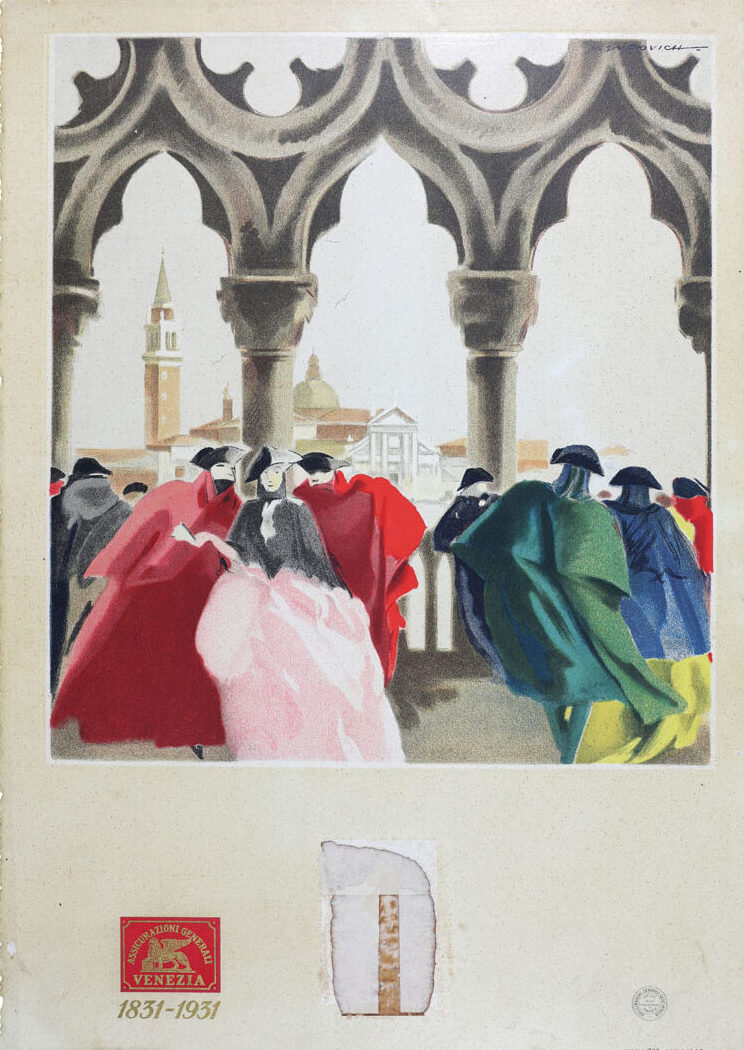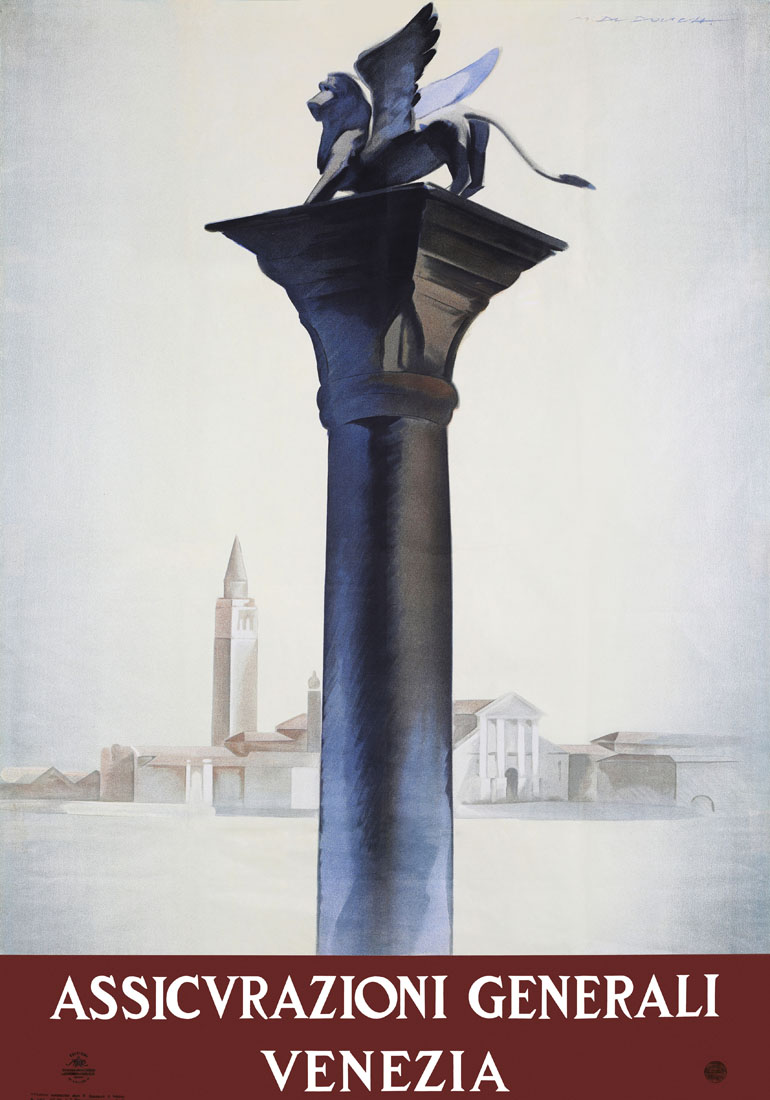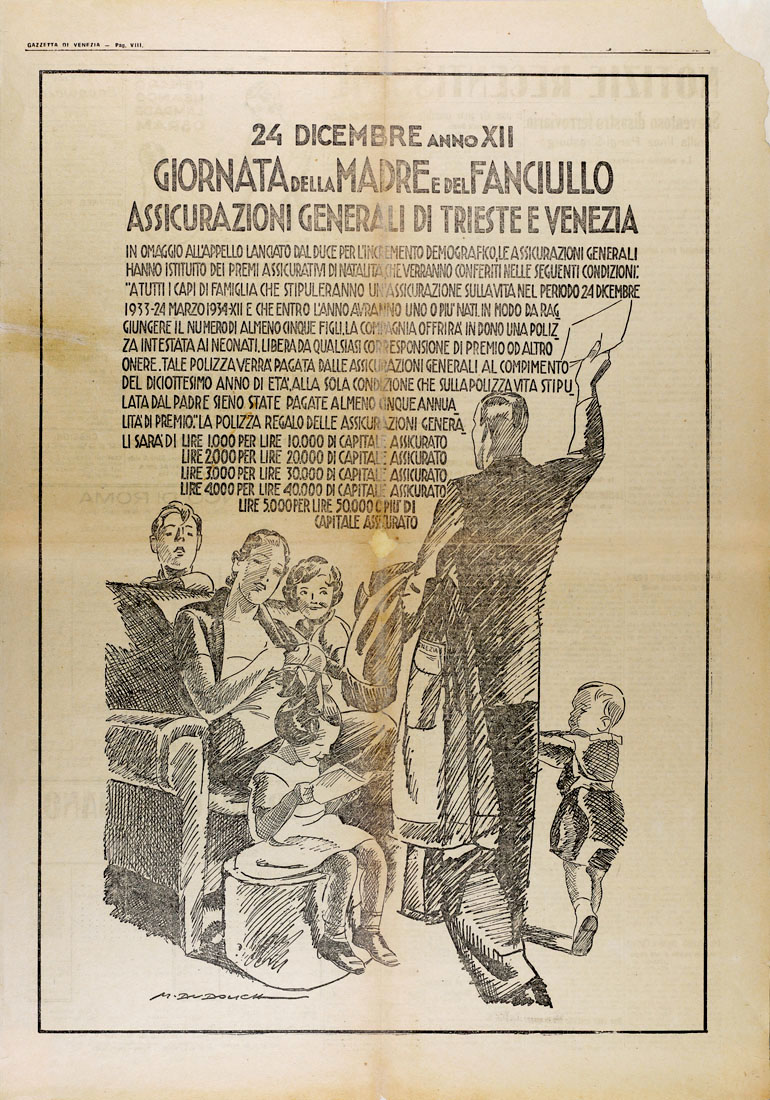The Mural Art that Stands the Test of Time. Marcello Dudovich and Generali
08 September 2023
Generali
Artistic Heritage
“At the end of the day, an advertising poster is no great ask. So how do you explain the fact that a given image can stay with you for years, often taking on great importance? Even the design of a simple object can slowly develop a personality of its own: even a simple figure can talk, sing, smile, shout. The advertising poster is a bit like a delayed-action bomb. That’s what makes it art: it works over time.” So says Marcello Dudovich (Trieste 1878 – Milan 1962), among the most globally renowned poster designers.
During his decade or so of working on commission for Generali, from 1928 to 1938, he produced various posters featuring Venice and its most iconic symbols (such as the posters with the two columns facing the San Marco basin and the lagoon) make frequent appearances
Also unmistakeable is the feminine figure that dates back to the early days of Generali’s visual communication approach and has assumed the position of an allegory of the company and insurance activity by extension.
During his six decades of activity, Dudovich lived through every stage of poster design’s golden era, leaving his indelible and unique imprint on the artform. His professional life was rich with collaborations, commissions and initiatives that kept him busy and brought him recognition, including as an illustrator of magazines, books, music scores and postcards, as well as his paintings.
His creative genius is intrinsically linked to the Casa Ricordi publishing house in Milan and the Neapolitan company, Mele. He was also behind countless designs for events, companies and industries (including Alfa Romeo, Pirelli, Shell, Agfa Film, Bugatti, Fiat, Martini, Campari, INA and Generali), yet despite all the posters and other advertising materials he created during the ‘20s and ‘30s, he never abandoned his illustrations of magazines and books.
In the 1920s, he founded the Star publishing house in Milan, for whom he created various fliers distributed by Impresa Generale Affissioni e Pubblicità (IGAP) in his role as artistic director.
During the Second World War and throughout the 1940s, Dudovich would increasingly dedicate himself to painting, primarily tempera, putting on and participating in solo and group exhibitions that grew over the following years. Also during this time, he designed murals in the homes of various friends.
His work is primarily remembered for displaying the luxury of the Italian bourgeoisie during the Belle Époque period: the sophistication and worldliness, the horse races and smart dress, and above all, the femininity of the women held up as beacons of refined elegance. The Generali Heritage includes a good example of it: a tempera painting on poster board dating back to the first quarter of the previous century (likely a preliminary sketch for a poster) entitled L’aspettavo (I’ve been waiting for you), depicting a young woman in a long dress, hat and veil stepping out of a carriage and offering a pleasant smile to the horseman who awaits her on a horse-drawn cart.
Sinewy, elegant forms make way during the following two decades for the virility of the masculine figure, with muscular bodies in tense poses, as evidenced by the African-inspired calendars and the posters advertising insurance for wheat sheafs preserved at the Historical Archive.
In addition to the posters, calendars and sketches in pencil and tempera (now available on-line in the dedicated database, valuable evidence of his work for Generali can be found in the circulars from the Veneto headquarters of the Company: important sources that give an insight into the works commissioned, dates, available formats, costs and how they were distributed throughout the agency network.
Another curio: the Archive also contains additional pearls that help to shine a light on the relationship between Dudovich and Generali: the personnel file of his father, Antonio (Trogir, Dalmatia, 1843 – ?). A supporter of Garibaldi from the outset, and a tireless employee, most likely in the central accounting office from 1867 to 1908, tasked with keeping the books, constantly preoccupied with providing for his large family, as can be seen in the preserved correspondence with the Head Office.
Another titbit: two of his black-and-white photos were included in jubilee cards donated to mark special occasions to Davide Cusin (employed as a secretary at the Trieste Head Office) in 1887 to mark his 25 years of service, and to Giuseppe Besso in 1895 on the occasion of his nomination as director of the Central Head Office.
The Archive also preserves the file containing the financial support offered to his mother, Elisa Cadorini, upon the passing of her husband, with a signed letter of thanks by Marcello Dudovich.
Regarding his contractual relationship with the Company, there is a letter sent by Marco Ara (general manager of Generali’s Veneto Head Office) in August 1933, which is indicative of the high expectations placed by the Company in the master artist. In the letter, Ara states, “ten days have passed since the agreed date and yet nothing have I received of the various projects commissioned. I am displeased.” Equally indicative is Dudovich’s response: “Ara my dear friend. Defer your displeasure for another occasion, for in Milan where I travel tomorrow, everything is ready.”
Unfortunately, there is no information regarding which of the commissions are being referred to in this exchange. Thanks to the circulars, it is possible to hypothesise: it is likely the poster created for the occasion of the so-called “Mother and Child Day”, established by the Fascist regime for December 24 of that year, but it could also be the proposal for the 1934 calendar featuring “a typical and suggestive depiction of a poetic altar of the Venetian lagoon”, i.e. a little shrine dedicated to Saint Mary, on top of a mooring or navigation column, of which the sketch is also preserved.
For more information: Generali. Circolo aziendale (edited by), The image: the Generali Group and the art of advertising, Trieste, Generali. Circolo aziendale, 2010.












